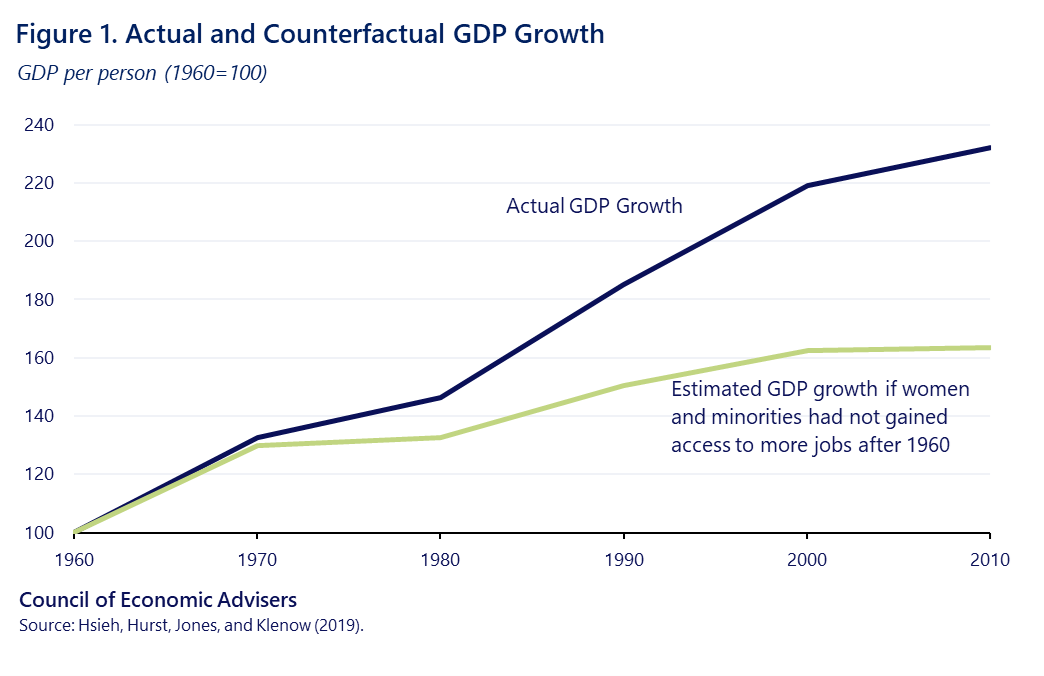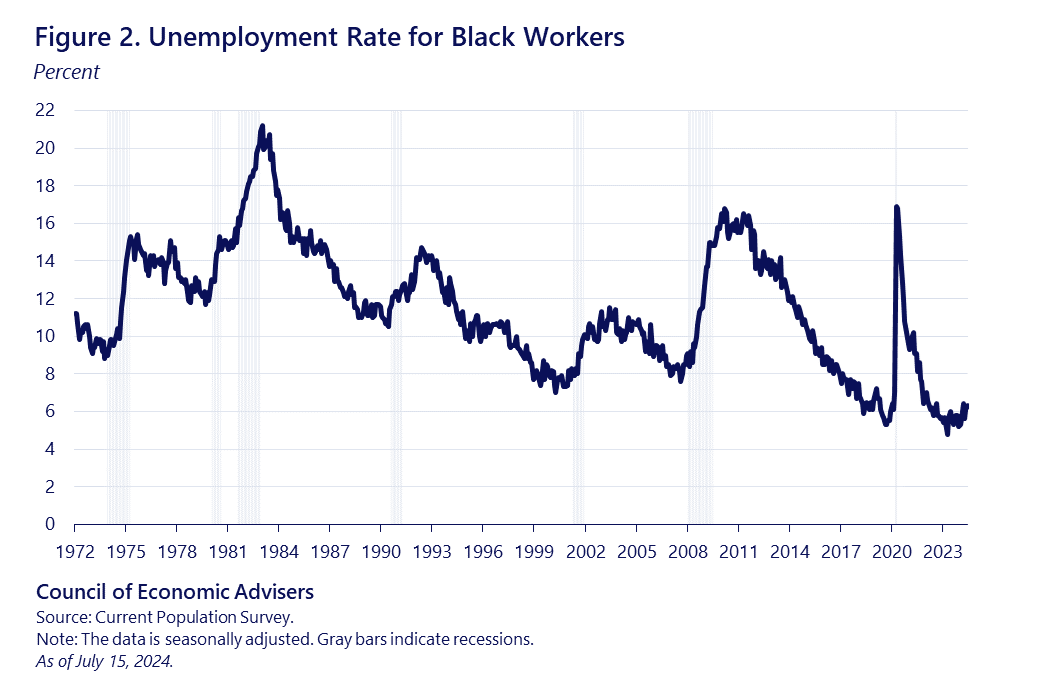How Investing in Equity Fosters the Goals of Investing in America
Heather Boushey, Chief Economist, Investing in America Cabinet
When the President took office, he identified a number of challenges in the American economy, including decades of rising inequality and the rapidly rising costs of climate change, which disproportionately harms lower-income communities. The President promised to build back better, putting in place a historic Investing in America agenda and prioritizing game-changing investments to enhance productive capacity across the country. But growth without equity is insufficient to empower working people and communities that for too long have been overlooked or left out by federal investment. Combatting systemic barriers and ensuring our Investing in America agenda reaches all communities improves people’s lives while also supporting a strong economy. For the 60th anniversary of the Civil Rights Act, the President is celebrating several achievements that have aimed to address inequality.
Since the beginning of this administration, President Biden and Vice President Harris have taken steps to advance equity and racial justice. From preserving African American history and culture to delivering a historically robust economic recovery for all Americans, the administration’s policies have prioritized equity. The President’s economic agenda does this by spurring investment in all communities – including in disadvantaged communities, and encouraging the creation of high-quality jobs.
This blog describes the economics of how investing in equity both empowers workers today and into the future and fosters stronger economic growth.
Improving racial and economic equity is a path to increasing overall economic growth
Addressing inequality leads to a more dynamic and resilient economy. Increased equity means that everyone has a chance to develop their skills efficiently and deploy their talents most effectively. Conversely, when people are unable to reach their full productivity because of discrimination or systemic inequality, the overall economy suffers.
Looking at these effects across the entire economy shows that the economic costs of inequity are quite high. For example, a study in Econometrica analyzes the changes in demographics of high-skilled occupations between 1960 and 2010. The authors estimate that during this period, improved job opportunities and talent allocation for women and communities of color drove up to 40 percent of the growth in aggregate U.S. gross domestic product (GDP) per person. Figure 1 depicts actual growth and growth in a counterfactual scenario without the increased access to opportunity.

These effects of inequality continue to reverberate throughout the economy. Research from authors at the San Francisco Federal Reserve Bank, Boston University, and Stanford University found that during the 30 year period from 1990 to 2019, the estimated economic cost to the total U.S. economy of racial and ethnic economic inequality was over $25 trillion. This study assumes that earnings were the same across all demographic groups, and then computes the labor earnings contribution to GDP. By eliminating these earnings gaps, prosperity would improve for racial minorities as well as the broader population. For instance, in 2019 alone, the authors find that eliminating gaps by race and ethnicity would have generated an additional $1.15 trillion to GDP.
The strong economic recovery made under President Biden has improved inequality along several metrics. Recent research shows that coming out of the pandemic recession, wage inequality has decreased—making a dent in decades of rising inequality. Using similar methodology to compute indexed real (inflation-adjusted) wages, the Council of Economic Advisers (CEA) found that in the post-pandemic period, low-income workers saw their wages grow by a higher percentage than those of high-income workers. Updated analysis indicates that between 2019:Q1 and 2024:Q1, real wages increased by 14 percentage points more for low-income workers than for high-income workers.
The economy has also made progress on reducing racial inequality. For example, CEA found that between the second halves of 2019 and 2023, real average wages increased 9.5 percent for Black workers and 6.7 percent for white workers, reducing economic inequality across race. The progress also extends to employment status. In April 2023, the Black unemployment rate hit an all-time record low of 4.8 percent (Figure 2). A strong economy produces benefits for workers of color, and as a consequence, improves racial equity.

Focusing on places too often left behind is good for growth
Addressing geographic inequality is another way to foster economic opportunity. Empirical evidence suggests that policies that actively encourage investment in places that are economically distressed generates relatively greater economic benefits. For example, according to one study, the economic benefits of policies that add jobs in targeted places are at least 60 percent greater in “distressed” regions than in “booming” ones.
The President’s Investing in America agenda centers this principle by targeting investments in historically underfunded communities. For instance, the Inflation Reduction Act specifically targets “Energy Communities,” which include communities historically reliant on fossil fuels for employment, wages, or tax revenue. The Energy Community Tax Credit applies a bonus up to 10 percent for production tax credits or 10 percentage points for investment tax credits for new initiatives in those communities. The U.S. Treasury Department reports that comparing before and after the passage of the Inflation Reduction Act, clean electricity investments rose in regions that qualified for this tax credit by an average of $1.4 billion per month more than in the rest of the country.
There are emerging indicators that private investors see the value of investing in communities that had been left behind. Private firms are disproportionately investing in places broadly defined as less advantaged. Prior to the Inflation Reduction Act, 68 percent of announced clean energy investments were in counties with incomes below the national median. After passage, that number rose to 75 percent. More broadly, the President’s economic policies are contributing to equitable growth across communities. As CEA has highlighted, the benefits of the strong economic recovery have been spread relatively evenly across U.S. states. The gap between the highest and lowest state unemployment rates hit a record low 3.2 percentage points in 2022 and was matched again in 2023.
The Biden-Harris administration is also committed to supporting minority-owned businesses. The Small Business Boom Report highlights that since 2020, both Black- and Latino-owned businesses saw a 4-percentage point increase in the share of government-backed Small Business Administration (SBA) loans. This represents a near-doubling for Black-owned business and more than a 50 percent increase for Latino-owned businesses. Over the past three years, total lending to these groups has accumulated to about $12 billion. In addition, in Fiscal Year 2023, a record $76.2 billion was awarded to small disadvantaged businesses, totaling 12.1% of federal procurement dollars.
Empowering workers can promote productivity and growth
Policies that empower workers can reduce barriers for workers as well as improve firm-level productivity. It is well documented that employers have high bargaining power relative to employees in the United States, more than other industrialized nations. Thus, higher unionization rates can increase compensation without reducing efficiency by redistributing labor market power. Unionization and paying workers fairly can reduce inequality, increase wages, and improve productivity. Furthermore, strong labor standards may communicate information about the quality of firms in the context of government contracting. One study demonstrates that companies that violate labor standards are also more likely to have performance problems.
Conclusion
There are many economic benefits to investing equitably and empowering communities. The Biden-Harris Administration is committed to tackling inequality and issues that prevent workers of all backgrounds from reaching their full potential. While progress has been promising thus far, our Administration will continue to make our economy work for all Americans from every background and community.
